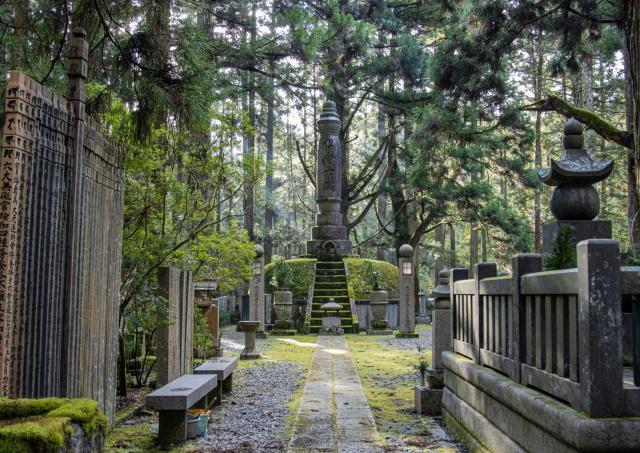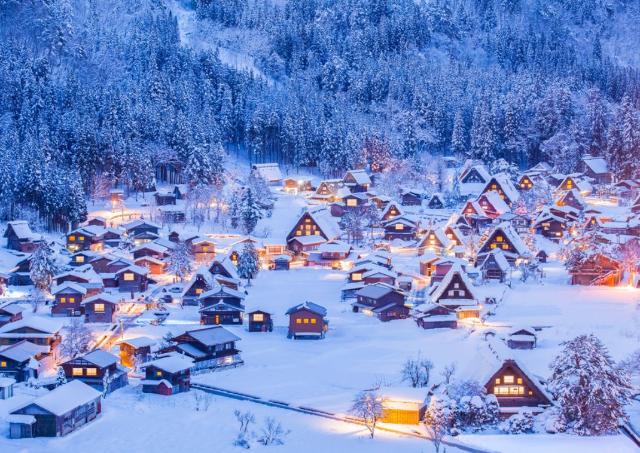Exploring Mount Koya: The Centre of Japanese Buddhism
So, you’ve awoken in a fairytale world. Test your senses one by one. With your eyes closed, take in the fumes of glittering cinnamon incense as it passes by your nose amidst the scent of sweet cedar. With the mist of the morning still rising against your palms, you narrowly open one eye and are struck by the bright emerald green of the mountain moss, its colour enhanced by the dew as it reflects the spotted sunlight beaming through the tall cedar canopies. You’re surrounded by nature, temples, and tombs – old and new.
Here, you’ll be met with the immeasurable beauty of ancient foliage encompassing centuries old shrines and sacred sites. Here, you’ll immerse yourself in the music of monks and the clinging of chimes. Here, you’ll pay respects to dynasties of the past and future. This is no fairytale world. Here, on Mount Koya, you’ll find yourself at the heart of Shingon Buddhism – one of the oldest religions of Japan.
Why is Koyasan Sacred?
Let us take you back to the Heian Period (794-1185) when a young man named Kukai (posthumously: Kobo Daishi) had just returned home to Japan from an explorative and spiritual trip to China. He brought back not just gifts but an emerging new type of esoteric Buddhism that would later be coined as Shingon Buddhism.
The ruling classes fawned over Kukai and this new sect, allowed him to perform rituals for the government and praised his writings. With their support, he searched for a base to further solidify the religion and came across the peaceful (and conveniently flat) mountainside of Mount Koya. Here, he and his followers tirelessly constructed a flowing chain of temples, and this is where Kukai perpetually resides to this day.
The Legend about Mt Koya
Fact and fiction often merge when it comes to the founding of Koyasan. The legend goes that while in China, Kukai had thrown a three-pronged ceremonial object, a sanko, across the sea towards an imagined future temple. Many years later in Japan, he came across a Shinto deity in the guise of a hunter. With him, tailed two wolves, one black and one white, and all three guided him up a mountain. There, he was astounded to find the sanko he had held on the shores of China buried deep into a tree on Koyasan’s future foundation.
The 117 Temples of Koyasan and Kongobu Ji Temple
When Kobo Daishi happened upon Koyasan more than a thousand years ago, the first site he conceptualised was Danjo Garan. It notably houses Chumon, the two-tiered entrance gate; Kondo, the main hall where a majority of significant ceremonies take place; Konpon Daito, a striking vermillion pagoda; as well as many other divine sights.
A beautiful stroll away from Danjo Garan, deep in the heart of Koyasan, you’ll find the core of Koyasan Shingon Buddhism: the temple Kongobuji. It harbours sprawling grounds to stroll through, golden rooms adorned with fusuma (sliding door) artwork to gaze at, a tatami-matted space to sip a warm cup of tea in; and Banryutei, Japan's largest rock garden, to meditate beside.
Despite its existence, Kongobuji is unsaid to be a physical temple, but the mountain itself. While there are more than one hundred impressive Buddhist temples dotted around Mount Koya, they are all thought of as one spiritual harmonious entity.
Getting There from Osaka
Photo: Richard Henry
Often referred to as Koyasan, Mount Koya resides directly east of Wakayama City – the capital of Wakayama prefecture. It’s more commonly a day trip from the northern neighboring metropolis of Osaka City.
If Osaka is your hub, hop on the Nankai-Koya express train at Shin-Imamiya train station and ride it to Gokurakubashi train station where you can take a rather amusing tracked cable car with multi-leveled seating to Koyasan Station.
Similar to a train car but built to sit comfortably at an angle, it’s an oddly fascinating piece of machinery. None the less, sit in the front for the best view!
While there are several directions to head, the most popular route is through Okunoin Cemetery. You read that right – a cemetery. Ride the number twenty-two bus for about twenty minutes before arriving at your goal – a grand total of two and a half hours from Osaka to the entrance of Okunoin. Not a bad distance to get from a sprawling city of nearly three million people to a tiny temple town of less than four thousand residents. You’re never too far from tranquility in Japan.
Explore the Okunoin Cemetery
Photo: Richard Henry
The fact that Kukai still inhabits Koyasan may perplex you. He officially died in the year 835 at the age of 62, so how could he still be living there?
In his will, Kukai requested to be entombed rather than fulfil the traditional Buddhist funeral rites of cremation. The story says that when they opened the doors of his resting place years later, he was still in a deep meditative trance; the only noticeable change being the long tendrils of his hair. To this day, on the eastern peak of Mount Koya in Okunoin Cemetery, you can visit Kobo Daishi's mausoleum, but you will not be allowed inside to behold his ever-present meditating form.
The rest of the impressive graveyard contains over 200,000 tombstones, making it the largest cemetery in Japan. A curious sight is a section of graves reserved for corporations that feature towering statues of their products including a Yakult bottle and coffee cup. The seemingly royal families of mega-corporations like Panasonic and Sony all have their resting sites on Koyasan – some spots filled and others yet to be filled. There’s plenty of room for future generations to join their loved ones on the holy mountain. It’s apparently the place to be – the afterlife penthouse, if you will.
A short walk past the freshly-shined family crests of electronics companies, old mausoleums start to steal the show. Graves (including the Tokugawa family tomb) covered in rich green moss and fern take center stage in the late morning sun. Symmetrical stone shapes and torii gates stand as if they’ve grown from the ground in a mix of lush flora. Ancient cedar trees fill spaces where mausoleums are not, and the scene becomes something out of a fantasy film. Where most western cemeteries are often avoided, Koyasan invites people to walk among centuries of people long left and life still growing.
The transcendental atmosphere of Okunoin is best felt after dusk. Night tours are widely available and strongly encouraged. With the dim-lit paths leading the way through moss-covered ancient stones, over bridges and under torii gates, you will find your way to the undamped lanterns of the Torodo Temple warming the night.
Walking with Monks of Shingon Buddhism
Photo: Richard Henry
A real pleasure of the stroll from entrance to temple is being constantly met with wandering men of the faith. Mixed with picture-snapping tourists, monks can be seen and heard with their wooden sandals smacking the pathway with each step and often while chanting. Similar to the seamless mixing of public and pacifists in garb in a place like Bangkok, monks are never too far from your peripherals.
The Okunoin Temple lies at the end of the path through the cemetery grounds. There, monks can be seen chanting in temple corners, young and old, speaking in prayer as old as the religion itself. It's here that the mausoleum of Kobo Daishi, the founder of the religion over a thousand years ago, can be found.
It feels as sacred as it is. Chants resonate against old wood. Incense consumes the air. The walkway is constantly swept with pride. It's a picturesque scene full of spots to stop and take in the vibe. The view from Gobyobashi Bridge is particularly serene. This is also the only spot to capture a shot of the temple since pictures are forbidden beyond the bridge.
Trinkets are sold near the temple entrance with all manners of incantations. They make for gorgeous souvenirs potentially full of power. If there was ever a place to buy one, it's definitely at the top of Mount Koya.
Stay at a Monastery for a Temple Stay
52 of these 117 temples provide a unique experience hardly found anywhere else in Japan: temple lodging, or shukubo in Japanese. Spend an eye-opening day and night amongst traditional Buddhist monks: be invited to observe the morning rituals, including morning prayers, and eat as they do by sampling shojin ryori (traditional buddhist vegetarian cuisine). Some accommodations even allow for a meditative walkthrough for beginners.
Retrace Kukai’s Footsteps on a Unesco World Heritage Trail
Koyasan is the pinnacle pilgrimage destination for many Japanese Shingon Buddhists. Seven trails surround Mount Koya with the title of most trodden being given to the Choishi-michi trail, named so because of the choishi, stone markers, that litter the ancient path.
Choishi-michi is around 24km long and begins at Jison-in Temple, which was lovingly built for Kukai’s mother. From there, you will traverse through flora and fauna—watch out for bears—until the path completes at the entrance gate of Mount Koya: Daimon. Meaning ‘great gate’, it sure is a great welcome after the seven-hour climb on a world heritage site.
Leave Refreshed
Photo: Richard Henry
Coming to Japan, shrines and temples are a dime-a-dozen. Most are uniquely spectacular in their own way. When you visit Mount Koya, you’re coming to the source of an important and long-standing sect of Japanese thought. Walking among what Kobo Daishi returned from China with all those centuries ago – a thought – is why it’s worth a visit. It’s a living museum full of generations of family clans who all wanted to rest atop the most sacred mountain of Japan. Whether you visit Mount Koya in late spring, summer, or early autumn for warmer weather, or in late autumn and winter for a colder experience, the beauty of this destination varies throughout the year.
The cemetery is, of course, not the only attraction on Mount Koya. It’s also encouraged to visit the rock garden of Kongobuji or the red pagoda of Konpon Daito. Whatever you come to see, come with a loose time schedule. Relax in an environment meant for meditation. You’re sure to leave with a mantra you’ll never forget.
For a custom tour exploring the Kansai region including a temple stay at Mt Koya, consider our Kansai Food and History tailor-made tour.
If you are craving an in-depth journey that includes an overnight visit to a monastery, then try our Nara Discovery Tour and Temple Stay.
Plan your trip with us
Get in touch with one of our travel consultants, they are ready to help you create the trip you always dreamed of.
Online Consultation



